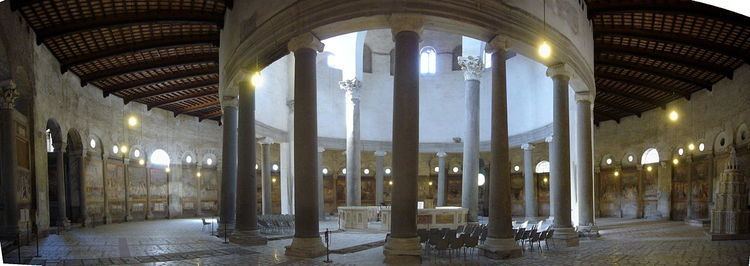 | ||
A martyrium (Latin) or martyrion (ancient Greek) (plural, "martyries" or "martyria") is a church of a specific architectural form, centered on a central element and thus built on a central plan, that is, of a circular or sometimes octagonal or cruciform shape.
Contents
History
The oldest Christian martyria were built at "a site which bears witness to the Christian faith, either by referring to an event in Christ's life or Passion, or by sheltering the grave of a martyr". Martyria, mostly small, were very common after the early 4th century, when Constantine became the first emperor to make the Nicene Creed the dominant religion of the Roman Empire. Martyria had no standard architectural plan, and are found in a wide variety of designs. There was often a sunken floor, or part of it, to bring the faithful closer to the remains of the saint, and a small opening, the fenestella, going from the altar-stone to the grave itself.
Later churches began to bring the relics of saints to the church, rather than placing the church over the grave; the first translation of relics was in Antioch in 354, when the remains of Saint Babylas, which were in a sarcophagus, were moved to a new church.
Development
The architectural form of the martyrium has been developed from Roman architecture, mainly based on imperial mausolea. Constantine the Great applied it for the tomb of Jesus at the Anastasis in Jerusalem (ca. 326-380s) and the Apostles' Church in Constantinople, while also erecting round mausolea for himself and his daughters. The first step towards creating a church based on an imperial mausoleum was made around 320, when Constantine connected what was supposed to become his own mausoleum, with a church structure.
The same form was later adopted by the early Islamic architecture, who employed it in the creation of a shrine known as the Dome of the Rock in Jerusalem, built much in the style of the Constantinian rotunda of the Church of the Holy Sepulchre, which it was supposed to create a "dialog of shrines" with, while looking down on it from a dominant position (the Temple Mount).
The central-plan martyrium church became a shape used for important churches which didn't contain important relics, as was the case of the Constantinian "Golden Octagon" at Antioch, perhaps also of the octagonal church of Caesarea Maritima (built ca. 480-500), San Vitale in Ravenna (526-547), and the Palatine Chapel in Aachen (ca. 792-805).
Examples
Martyria that remain in something like their original form include the following:
Other celebrated Martyria include:
Etymology
The origin of the name of the Christian martyrium is as follows: Ancient Greek martys, "witness", to martyrion, "testimony", to Late and Ecclesiastical Latin martyrium.
